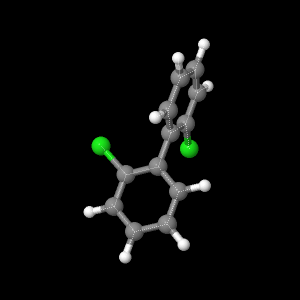Once the molecule file is fully loaded, the image at right will become live. At that time the "activate 3-D" icon
![]()
will disappear.
The molecular geometry of 2, 2'-chloro biphenyl was calculated using two
semi-empirical methods (AM1 and PM3) as well as the ab initio HF-SCF
method with three different basis sets (6-21G, 6-31G, and DZV).
Table 1: Dipoles, dihedral angles, and energies for each level of theory.
2,2'-chlorobiphenyl
| Dipole (Debye)
| Dihedral Angle (°)
| Engergy (Hartree)
|
AM1
| 1.526426
| 90.3
| -87.9499
|
PM3
| 1.052166
| 85.0
| -80.0244
|
6-21G
| 2.468097
| 85.0
| -1377.4957
|
6-31G
| 3.139907
| 84.8
| -1377.8424
|
DZV
| 2.962393
| 92.2
| -1377.8
|
Literature
| -------
| 84.9(3)
| -------
|
Besides reference (3), data concerning bond lengths and bond angles
could not be found for this molecule. A close comparison molecule was
chlorobenzene, and data for the corresponding bond lengths and angles
for literature comparison can be found using this link:
https://cccbdb.nist.gov/exp2.asp (2). The following buttons show the calculated geometries for each level of theory.
Molecular orbitals were also calculated in the geometry optimization. The HOMO was determined by filling
orbitals starting with the lowest energy orbital and selecting the
highest energy occupied orbital. The LUMO was determined by taking the
lowest energy orbital that was not occupied by electrons.
For comparison vibrational frequencies, no data could be found for this
molecule. For a comparison IR spectrum, here is a link to a spectrum for
chlorobenzene, which would have similar stretches
http://webbook.nist.gov/cgi/cbook.cgi?ID=C108907&Units=CAL&Type=IR-SPEC.
Here are some example vibrations from this 2, 2'-chlorobiphenyl
Similar to the vibrational frequencies, no electronic transition data
could be found for comparison to the calculations made. The following
link shows a UV-Vis spectrum for a similar molecule, chlorobenzene.
http://webbook.nist.gov/cgi/cbook.cgi?ID=C108907&Units=CAL&Mask=400#UV-Vis-Spec.
Table 2: UV-Vis absorption energy for ab initio methods
|
UV-Vis Absorption (cm-1)
|
6-21G
|
52909.92
|
6-31G
|
51858.32
|
DZV
|
50692.79
|
Based on template by A. Herráez as modified by J. Gutow
Using directory /Users/student/Documents/KFTR/2,2'-chloro biphenyl
adding JmolPopIn.js
...jmolApplet0
...adding AM1_Bond_Lengths.png
copying and unzipping jsmol.zip directory into /Users/student/Documents/KFTR/2,2'-chloro biphenyl
...adding AM1_Bond_Lengths.spt
...jmolApplet1
...adding PM3_Bond_Lengths.png
copying and unzipping jsmol.zip directory into /Users/student/Documents/KFTR/2,2'-chloro biphenyl
...adding PM3_Bond_Lengths.spt
...jmolApplet2
...adding 6-21G_Bond_Lengths.png
copying and unzipping jsmol.zip directory into /Users/student/Documents/KFTR/2,2'-chloro biphenyl
...adding 6-21G_Bond_Lengths.spt
...jmolApplet3
...adding 6-31G_Bond_Lengths.png
copying and unzipping jsmol.zip directory into /Users/student/Documents/KFTR/2,2'-chloro biphenyl
...adding 6-31G_Bond_Lengths.spt
...jmolApplet4
...adding DZV_Bond_Lengths.png
copying and unzipping jsmol.zip directory into /Users/student/Documents/KFTR/2,2'-chloro biphenyl
...adding DZV_Bond_Lengths.spt
...jmolApplet5
...adding AM1_Bond_Angles.png
copying and unzipping jsmol.zip directory into /Users/student/Documents/KFTR/2,2'-chloro biphenyl
...adding AM1_Bond_Angles.spt
...jmolApplet6
...adding PM3_Bond_Angles.png
copying and unzipping jsmol.zip directory into /Users/student/Documents/KFTR/2,2'-chloro biphenyl
...adding PM3_Bond_Angles.spt
...jmolApplet7
...adding 6-21G_Bond_Angles.png
copying and unzipping jsmol.zip directory into /Users/student/Documents/KFTR/2,2'-chloro biphenyl
...adding 6-21G_Bond_Angles.spt
...jmolApplet8
...adding 6-31G_Bong_Angles.png
copying and unzipping jsmol.zip directory into /Users/student/Documents/KFTR/2,2'-chloro biphenyl
...adding 6-31G_Bong_Angles.spt
...jmolApplet9
...adding DZV_Bond_Angles.png
copying and unzipping jsmol.zip directory into /Users/student/Documents/KFTR/2,2'-chloro biphenyl
...adding DZV_Bond_Angles.spt
...jmolApplet10
...adding DZV_HOMO.png
copying and unzipping jsmol.zip directory into /Users/student/Documents/KFTR/2,2'-chloro biphenyl
...adding DZV_HOMO.spt
...jmolApplet11
...adding DZV_LUMO.png
copying and unzipping jsmol.zip directory into /Users/student/Documents/KFTR/2,2'-chloro biphenyl
...adding DZV_LUMO.spt
...jmolApplet12
...adding DZV_Partial_Atomic_Charges.png
copying and unzipping jsmol.zip directory into /Users/student/Documents/KFTR/2,2'-chloro biphenyl
...adding DZV_Partial_Atomic_Charges.spt
...jmolApplet13
...adding DZV_Electrostatic_Potential.png
copying and unzipping jsmol.zip directory into /Users/student/Documents/KFTR/2,2'-chloro biphenyl
...adding DZV_Electrostatic_Potential.spt
...jmolApplet14
...adding 3442_84_cm-1.png
copying and unzipping jsmol.zip directory into /Users/student/Documents/KFTR/2,2'-chloro biphenyl
...adding 3442_84_cm-1.spt
...jmolApplet15
...adding 1783_04_cm-1.png
copying and unzipping jsmol.zip directory into /Users/student/Documents/KFTR/2,2'-chloro biphenyl
...adding 1783_04_cm-1.spt
...jmolApplet16
...adding 1127_33_cm-1.png
copying and unzipping jsmol.zip directory into /Users/student/Documents/KFTR/2,2'-chloro biphenyl
...adding 1127_33_cm-1.spt
![]() will disappear.
will disappear.
